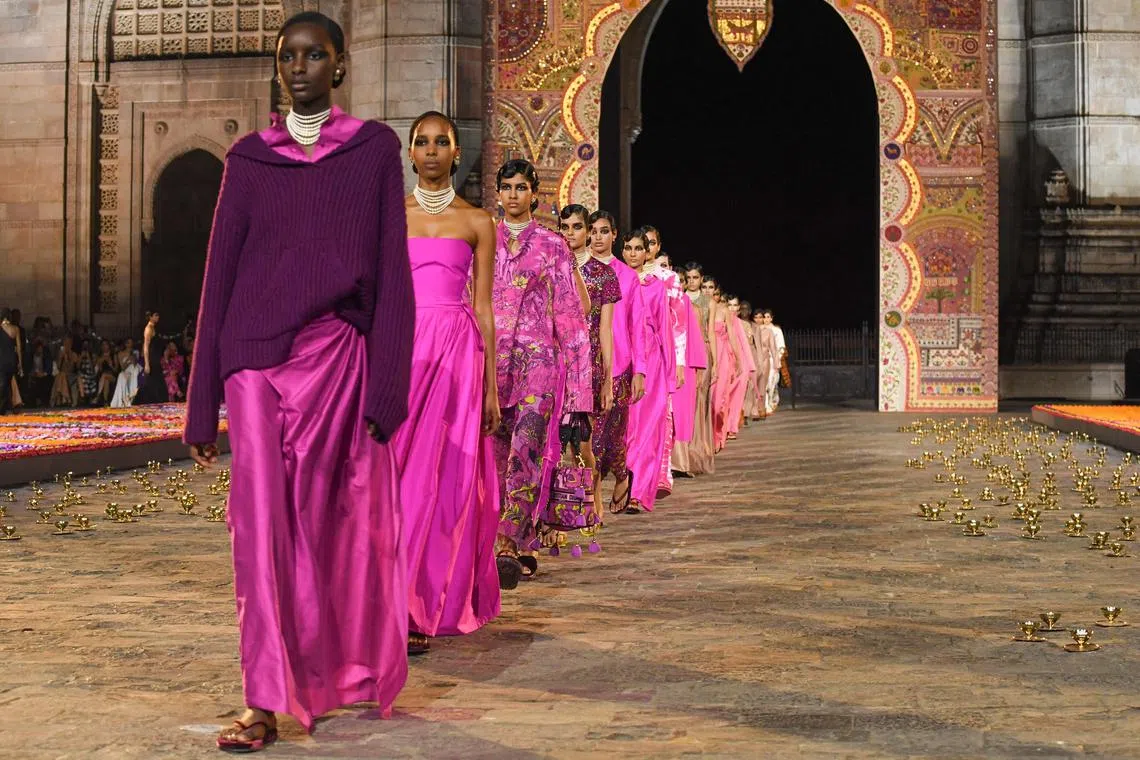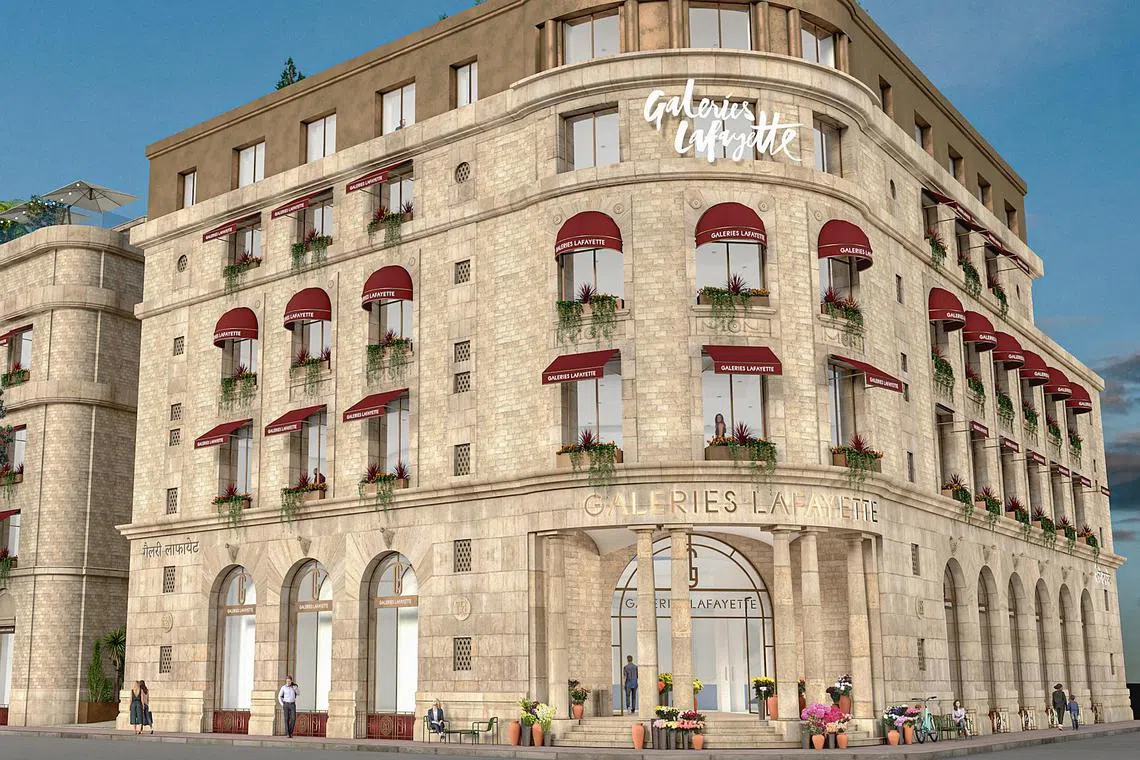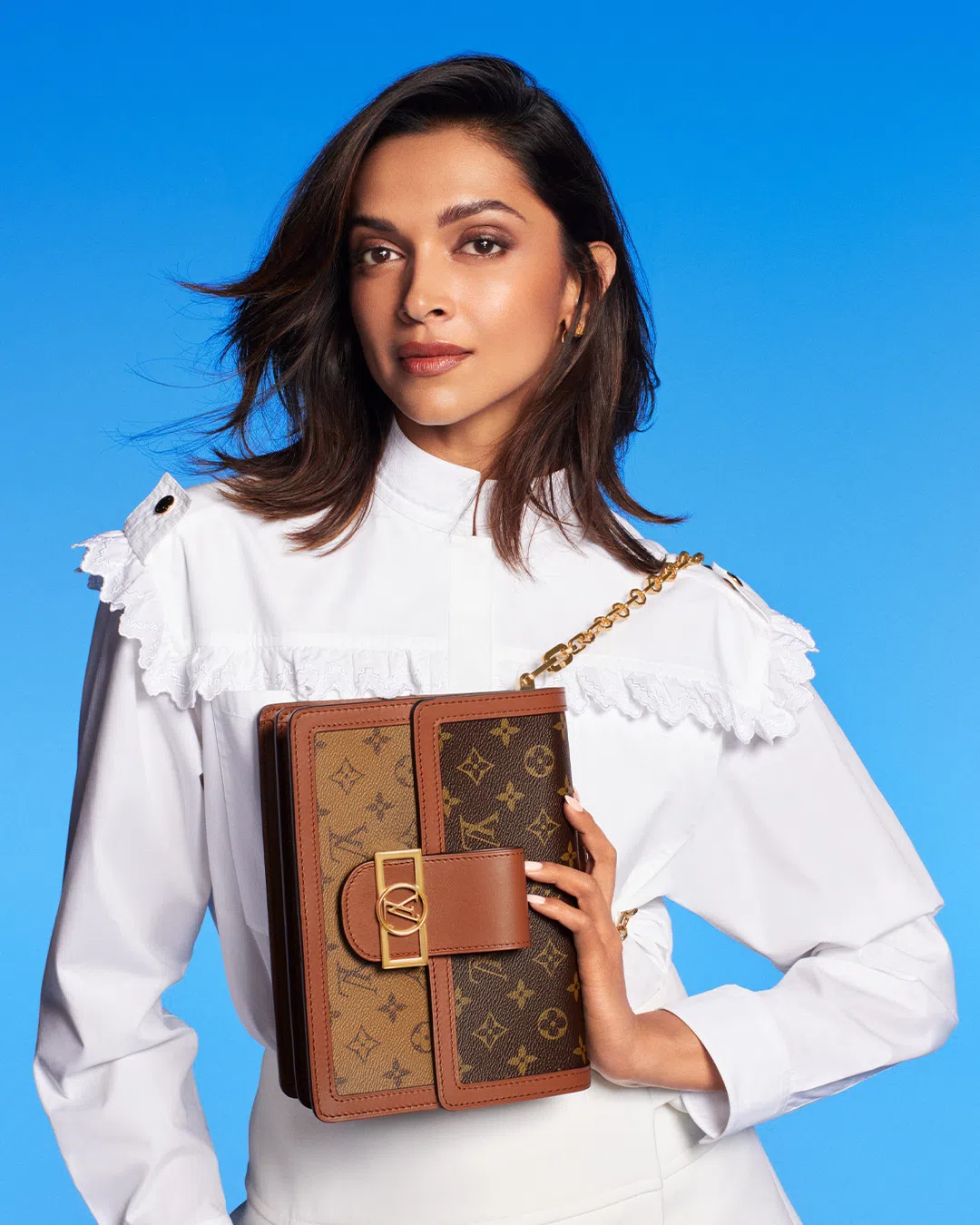India’s growing economy attracts Western luxury brands
Sign up now: Get insights on Asia's fast-moving developments

Models present creations from Christian Dior's Fall 2023 collection during a fashion show in Mumbai on March 30, 2023.
PHOTO: AFP
Follow topic:
NEW DELHI – In the heart of Mumbai, the interiors of two 100-year-old heritage buildings are being completely refurbished to house department store Galeries Lafayette, which will have more than 200 luxury and designer brands.
Spread across 90,000 sq ft, the luxury department store, a tie-up between the high-end French department store chain and Indian firm Aditya Birla Fashion and Retail, will open in 2024.
Coming up in the city’s Fort area, an upmarket location for high-end stores, including those of Indian designers like Sabyasachi Mukherjee, the niche department store is a response to the growing appetite for luxury in the country.
“This collaboration is a strong signal of our belief in the growing depth of the luxury market in India,” said Mr R. Sathyajit, CEO of the luxury division at Aditya Birla Fashion and Retail Limited.
He said: “This growth is largely driven by aspirational young and affluent consumers with global exposure who are willing to spend on luxury products and experiences, a rise in entrepreneurship, a strong middle class, and deeper penetration of e-commerce.”
The tie-up also includes launching an e-commerce platform and a store in Delhi.
Unlike China, India may not have been a major market for Western luxury brands amid challenges of finding retail space and being a tough place to do business amid complex regulations.
But that seems to be changing due to the increased spending power in one of the world’s fastest-growing economies, which is expected to grow at an estimated 6 per cent in 2023 in spite of a global slowdown.

The upcoming Galeries Lafayette store in the Fort area of Mumbai.
PHOTO: ADITYA BIRLA FASHION AND RETAIL LIMITED
The World Bank ranked India 63rd in 2022, from 142 in 2014, for ease of doing business.
According to Euromonitor International, India’s luxury goods market will grow by 4.8 per cent over the next five years, and is expected to reach an estimated US$ 7.5 billion (S$9.9 billion).
The South Asian country has seen an exponential increase in the number of millionaires. According to the Credit Suisse Global Wealth Report 2022, the number of millionaires in India was estimated to double from 796,000 in 2021 to 1.6 million in 2026.
Mr Anul Sareen, project manager at Euromonitor International, which provides strategic market research, said “luxury players are taking notice and becoming bullish about their efforts in the country”.
There has always been an appetite for Western luxury brands in India, even before designer stores came to the country, with wealthy Indians buying luxury fashion goods during their trips abroad.
Louis Vuitton was the first international premium luxury brand to arrive in 2002, followed by Dior, Hermes, Burberry and Chanel.
But the change now is that the brands are targeting upwardly mobile Indians, said Mr Arvind Singhal, chairman of Technopak Advisors, a retail consultancy.
“When you look into the traditional rich of India, they understand these brands. But there is a new class of first-time rich whose backgrounds have been modest. They could be professionals or start-up entrepreneurs. They don’t necessarily have an understanding or awareness of these brands,” said Mr Singhal.
“Now you will see brand building and development efforts, because the growth will now come from these first-time customers. That is the shift now.”
French luxury fashion house Dior, which opened its first store in Delhi’s Oberoi Hotel in 2006, presented its pre-autumn 2023 collection in India with the Gateway of India monument, a major landmark in the city, as the backdrop.
Earlier, brands like Yves Saint Laurent had one-off shows, but Dior was the first to host a seasonal show – meaning it was part of its schedule of shows usually held in fashion capitals – in India on March 30, 2023.

Models present creations from Christian Dior’s Fall 2023 collection during a fashion show in Mumbai on March 30, 2023.
PHOTO: AFP
Dior said it was also a celebration of the relationship between Dior, Chanakya Ateliers and the Chanakya School of Craft, which trains women from low-income communities in hand embroidery and craftsmanship. Indian embroiderers have long contributed to French fashion.
The collection included evening coats, sari-inspired straight skirts and traditional Indian cuts, as well as pants, boleros, jackets and tops, Dior said in a release. It also included colour block sequence dedicated to silks in shades of green, yellow, pink and purple
“Dior Indian clients are very attached to the values and history of the house. This friendship has always transcended borders and continues to grow through exhibitions, store openings and unique encounters, such as this Dior show, which is more meaningful than ever,” said a Dior spokesman.
In May 2022, Louis Vuitton appointed Bollywood superstar actress Deepika Padukone as a “house ambassador”.

Bollywood actress Deepika Padukone as Louis Vuitton’s house ambassador.
PHOTO: LOUIS VUITTON/FACEBOOK
Italian jewellery giant Bvlgari appointed movie star Priyanka Chopra Jonas in 2021 as its global brand ambassador and sells mangalsutra, a chain that a groom ties around a bride’s neck in Hindu weddings.
Italian fashion house Valentino opened its first boutique in India at the DLF Emporio Mall, a mall housing high-end luxury labels, in Delhi in July 2022. French fashion house Balenciaga, Indian media reports said, is also planning to open a store.
Vogue magazine in February called it luxury’s “coming of age moment” in India.

Italian fashion house Valentino opened its first boutique in India at the DLF Emporio Mall.
PHOTO: DLF EMPORIO MALL/FACEBOOK
Apart from fashion, appetite for luxury has grown across the board.
In real estate, for instance, the luxury end has been the fastest to recover from the Covid-19 pandemic.
Real estate firm DLF said that it sold 1,137 luxury apartments, priced at 70 million rupees (S$1.1 million) and above, within three days in March in Gurugram, a satellite city near Delhi.
German luxury carmaker Mercedes-Benz sold a record number of 15,822 cars in 2022, compared with 11,242 the year before.
But expanding in India is not expected to be easy, with high competition from Indian designers and lack of retail space for now.
“A show like Dior’s may be ideal for engagement with existing/new consumers, but will not change things overnight for the retailer. With dynamics in the Indian market far different compared with other global markets, luxury retailers would need to constantly analyse the needs of consumers here,” said Mr Sareen.
But brands remain bullish.
“As the Indian economy grows to US$5 trillion over the next few years, we will witness a spike in the top-tier consuming class as well as the aspirational middle class. This growing depth of consumers is bound to inspire more brands to enter and invest in the market,” said Mr Sathyajit.


